Gentiana clausa, closed gentian, is an native perennial herbaceous plant. It has unusual flowers that look like flower buds but are in full bloom. They are an attractive blue and bloom in the fall. It has other common names: meadow closed gentian and bottle-gentian. Characteristics that distinguish G. clausa from its look-alike, G. andrewsii, are presented.
Flowers
Inflorescence/Flower cluster:
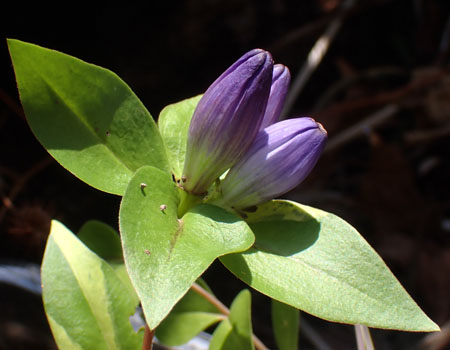
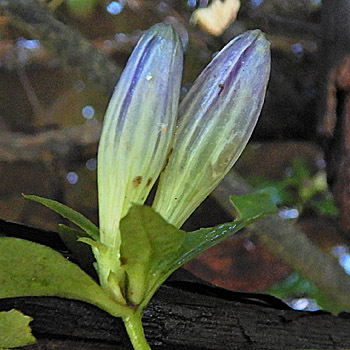
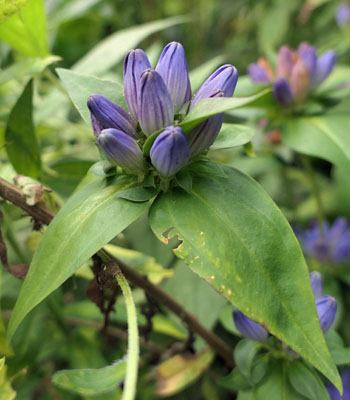
Individual Flower:
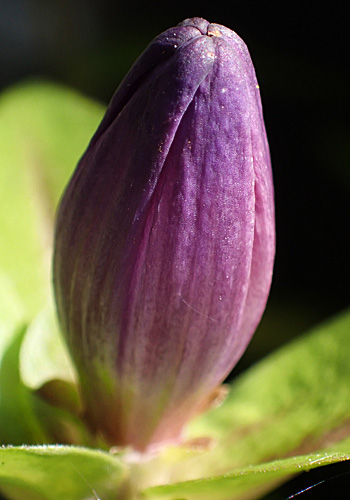
The Gentiana clausa flower even at maturity resembles a large closed bud, 1 to 1.5 inches long. The flower never opens. The flowers are different shades of blue, violet, and rarely white. The corolla has vertical ridges and appear wrinkled.
There are 5 stamens and a pistil with a stigma that divides in 2. There are nectaries at the base of the petals.
The flower has 5 petals with connecting tissue called plaits, folds, pleats, or floral appendages. These parts can be easily seen in a gentian flower like Pinebarren gentian (click here).
Unlike Pinebarren gentian where the lobes and plaits are obvious, in G. clausa the lobes and plaits are fused and the corolla is closed up so that the distinctions are not obvious.
Flower lobes and plaits in Gentiana clausa.
Gently pressing on the 'closed' corolla opens the tip so that the lobes and plaits can be observed. The lobes are blue and the interconnecting plaits are blue or whitish and folded inward. It is the relative heights of the lobes and plaits that helps distinguish between the closed gentian species.
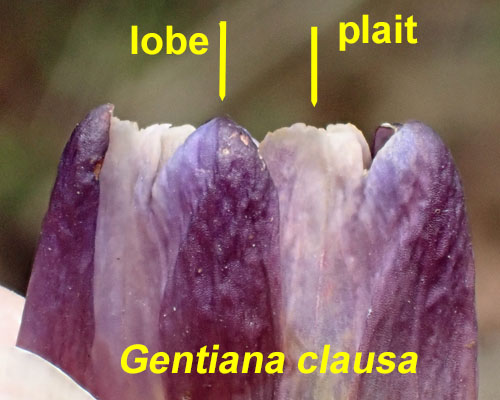

A closer look at the flower lobes and plaits in G. clausa.
Features of the lobes and plaits.
- The plaits are about as long as the lobes.
- The plaits have teeth
- lobes are rounded at the top
- lobes are about as wide as the plaits near the tips
In contrast, in G. andrewsii, the plaits are longer than the lobes and have fringes. Also the top of the lobes are narrower.

Since in G. clausa the blue lobes are as long as the plaits, frequently the plaits do not extend beyond the lobes at the flower tops. In the photo, no evidence of the plaits can be seen.

Sepals/Calyx There are 5 sepals but they are fused into a half inch long tube that separates into 5 small spreading lobes. The lobes are obovate (wider at the end away from the attachment) to broad-lanceolate (wider at base, tapering at both ends). Under magnification these lobes are ciliated. At the base of the flower beneath the sepals is a pair of bracts and a pair of leaves.
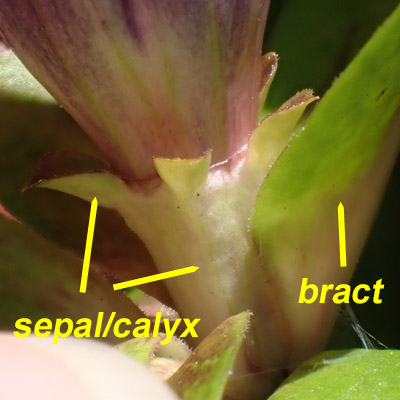
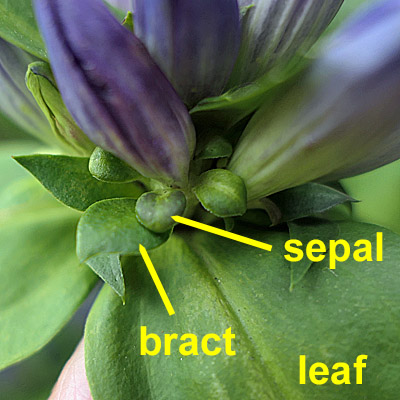
Pollination G. clausa is primarily pollinated by bumblebees because they are large enough to pry open the closed flower. Sometimes insects make a hole at the base of the flower and get the nectar but do not contribute to pollination.
Plant - Leaves - Habitat
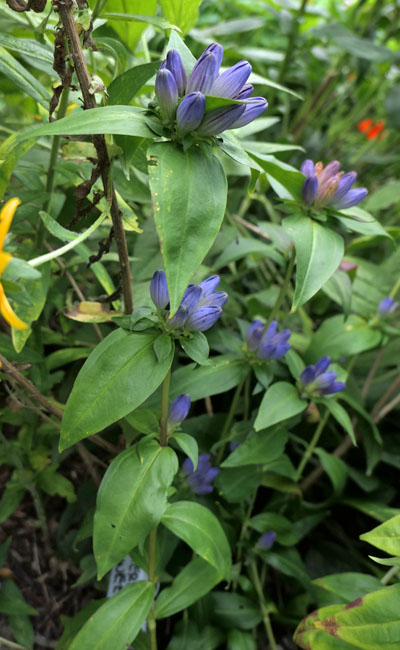 The G. clausa plant is a upright perennial 1-2' tall. It can have multiple stems that emerge from the taproot. These stems are usually unbranched.
The G. clausa plant is a upright perennial 1-2' tall. It can have multiple stems that emerge from the taproot. These stems are usually unbranched.
However, the stems are weak and frequently fall over in the shade. Flowers developing in the axils are shown.
The leaves are opposite and sessile. They are up to 4" long and 1" across. They are wider at the base tapering to a point at the tip. Sometimes the leaves are broadest in the middle.
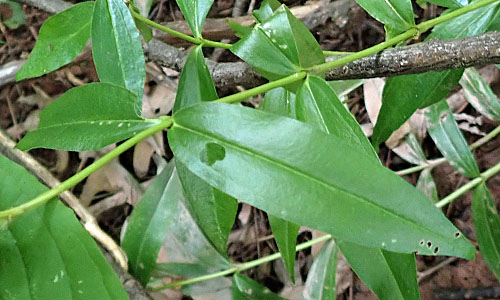
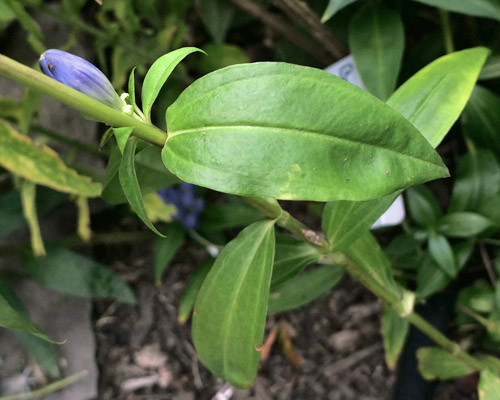
The margins of the leaves are actually ciliated. They are visible with low magnification. This characteristic is sometimes mentioned when differentiating Gentiana species.
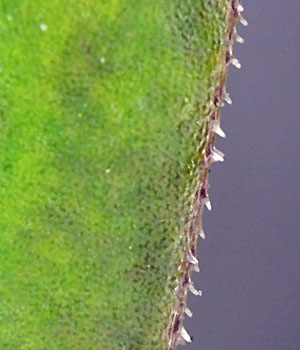
Habitat: The plant grows best in part shade with plenty of moisture.
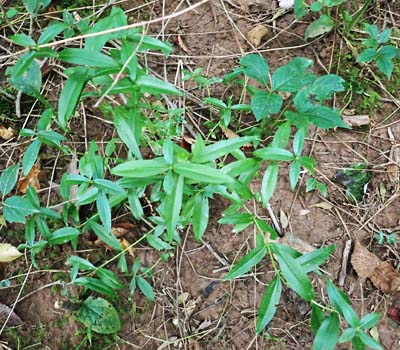
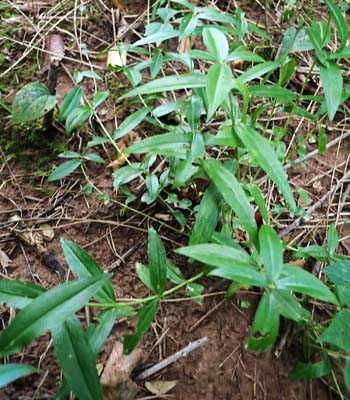
Text by Millie Ling and all photos by Hubert & Millie Ling. Photos: September, cultivation and in the wild at a preserve in Morris county. G. clausa blooms a little earlier than G. andrewsii.
Additional information
Additional information / references:
- The USDA website shows Gentiana clausa distribution in the US and other information: https://plants.sc.egov.usda.gov/home/plantProfile?symbol=GECL
- GoBotany - key to Gentiana. https://gobotany.nativeplanttrust.org/dkey/gentiana/#all
- GoBotany gives excelent comparisons of look-a-like species. https://gobotany.nativeplanttrust.org/species/gentiana/clausa/
- Jersey Friendly Yards has excellent information on cultivation: https://www.jerseyyards.org/plant/gentiana-clausa/
- Name That Plant: descriptions. http://www.namethatplant.net/plantdetail.shtml?plant=2492
- Mt Cuba Center: descriptions. https://mtcubacenter.org/plants/closed-bottle-gentian/
- GENTIANA CLAUSA A VALID SPECIES https://www.jstor.org/stable/pdf/41763944.pdf?refreqid=fastly-default%3Af28bb2e4f46a6819de5d728617c36a03&ab_segments=&origin=&initiator=&acceptTC=1
- Page on the look-alike - Gentiana andrewsii gentiana_andrewsii.html